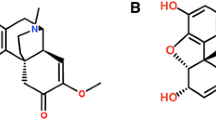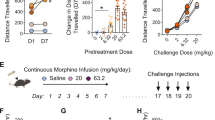Abstract
Rationale
Recent studies have shown that pharmacological inhibition of the 12-lipoxygenase pathway selectively blocks opioid inhibition of GABAergic synaptic currents. A similar mechanism has been shown for the regulation of glutamate release in the ventral tegmental area (VTA) during acute withdrawal from morphine, although the functional significance of these effects in vivo are not known.
Objectives
We have utilized mice with a disruption of the "leukocyte-type" 12-lipoxygenase gene (12-LO−/− mice) to examine a variety of general behavioral responses as well as several specific responses to morphine and cocaine.
Methods
Behavioral responses to morphine include sensitivity to thermal stimuli and withdrawal from chronic morphine treatment. Responses to cocaine were measured through locomotor activity.
Results
General behavioral responses in 12-LO−/− mice are not different from their wild-type controls. However, these mutant mice showed enhanced morphine-induced analgesia. However, this effect is eliminated following chronic morphine treatment. In addition, 12-LO−/− mice demonstrated enhanced somatic signs of opiate withdrawal relative to littermate controls. Lastly, cocaine-mediated increases in locomotor activity was augmented acutely but not chronically in 12-LO−/− mice.
Conclusions
Together, these results suggest a role for metabolites of arachidonic acid metabolism in morphine- and cocaine-induced behavioral responses and may reflect a utilization of this pathway following acute but not chronic drug administration.




Similar content being viewed by others
References
Basbaum AI, Fields HL (1984) Endogenous pain control systems: brainstem spinal pathways and endorphin circuitry. Annu Rev Neurosci 7:309–338
Bozarth MA, Wise RA (1984) Anatomically distinct opiate receptor fields mediate reward and physical dependence. Science 224:516–517
Cameron DL, Williams JT (1993) Dopamine D1 receptors facilitate transmitter release. Nature 366:344–347
Chieng B, Christie MJ (1994) Hyperpolarization by opioids acting on μ-receptors of a subpopulation of rat periaqueductal gray neurons in vitro. Br J Pharmacol 113:121–128
Chieng B, Christie MJ (1996) Local opioid withdrawal in rat single periaqueductal gray neurons in vitro. J Neurosci 16:7128–7136
Chomczynski P, Sacchi N (1987) Single-step method of RNA isolation by acid guanidinium thiocyanate-phenol-chloroform extraction. Anal Biochem 162:156–159
Crawley JN, Paylor R (1997) A proposed test battery and constellations of specific behavioral paradigms to investigate the behavioral phenotypes of transgenic and knockout mice. Hormones Behav 31:197–211
Fry JP, Herz A, Zieglgansberger W (1980) A demonstration of naloxone-precipitated opiate withdrawal on single neurons in the tolerant/dependent rat brain. Br J Pharmacol 68:585–592
Guitart X, Thompson MA, Mirante CK, Greenberg ME, Nestler EJ (1992) Regulation of cyclic AMP response element-binding protein (CREB) phosphorylation by acute and chronic morphine in the rat locus coeruleus. J Neurochem 58:1168–1171
Hedqvist P (1977) Basic mechanisms of prostaglandin action. Annu Rev Pharmac Tox 17:259–279
Ingram SL, Vaughan CW, Bagley EE, Connor M, Christie MJ (1998) Enhanced opioid efficacy in opioid dependence is caused by an altered signal transduction pathway. J Neurosci 18:10269–10276
Kalivas PW (1993) Neurotransmitter regulation of dopamine neurons in the ventral tegmental area. Brain Res Brain Res Rev 18:75–113
Kalivas PW, Stewart J (1991) Dopamine transmission in drug- and stress-induced behavioral sensitization. Brain Res Rev 16:223–244
Kalivas PW, Duffy P (1998) Repeated cocaine administration alters extracellular glutamate in the ventral tegmental area. J Neurochem 70:1497–1502
Kalivas PW, Duffy P, Eberhardt H (1990) Modulation of A10 dopamine neurons by gamma-aminobutyric acid agonists. J Pharmacol Exp Ther 253:858–866
Koob GF, Maldonado R, Stinus L (1992) Neural substrates of opiate withdrawal. Trends Neurosci 15:186–191
Li J, Ning G, Duncan SA (2000) Mammalian hepatocyte differentiation requires the transcription factor HNF-4 alpha. Genes Dev 14:464–474
Maldonado R, Stinus L, Gold LH, Koob GF (1992) Role of different brain structures in the expression of the physical morphine withdrawal syndrome. J Pharmacol Exp Ther 261:669–677
Mansour A, Fox CA, Akil H, Watson SJ (1995) Opioid-receptor mRNA expression in the rat CNS: anatomical and functional implications. Trends Neurosci 18:22–29
Manzoni OJ, Williams JT (1999) Presynaptic regulation of glutamate release in the ventral tegmental area during morphine withdrawal. J Neurosci 19:6629–6636
Matsuoka I, Maldonado R, Defer N, Noel F, Hanoune J, Roques BP (1994) Chronic morphine administration causes region-specific increase of brain type VIII adenylyl cyclase mRNA. Eur J Pharmacol 268:215–221
Nestler EJ (2001) Molecular basis of long-term plasticity underlying addiction. Nat Rev Neurosci 2:119–128
Nestler EJ, Alreja M, Aghajanian GK (1994) Molecular and cellular mechanisms of opiate action: studies in the rat locus coeruleus. Brain Res Bull 35:521–528
Nishiyama M, Watanabe T, Ueda N, Tsukamoto H, Watanabe K (1993) Arachidonate 12-lipoxygenase is localized in neurons, glial cells, and endothelial cells of the canine brain. J Histochem Cytochem 41:111–117
Piomelli D, Greengard P (1990) Lipoxygenase metabolites of arachidonic acid in neuronal transmembrane signalling. Trends Pharmacol Sci 11:367–373
Piomelli D, Volterra A, Dale N, Siegelbaum SA, Kandel ER, Schwartz JH, Belardetti F (1987) Lipoxygenase metabolites of arachidonic acid as second messengers for presynaptic inhibition of Aplysia sensory cells. Nature 328:38–43
Robinson TE, Becker JB (1986) Enduring changes in brain and behavior produced by chronic amphetamine administration: a review and evaluation of animal models of amphetamine psychosis. Brain Res Rev 11:157–198
Russell JA, Leng G, Bicknell RJ (1995) Opioid tolerance and dependence in the magnocellular oxytocin system: a physiological mechanism? Exp Physiol 80:207–340
Shimizu T, Wolfe LS (1990) Arachidonic acid cascade and signal transduction. J Neurochem 55:1–13
Shinjo F, Yoshimoto T, Yokoyama C, Yamamoto S, Izumi S, Komatsu N, Watanabe K (1986) Studies on porcine arachidonate 12-lipoxygenase using its monoclonal antibodies. J Biol Chem 261:3377–3381
Stewart J, Badiani A (1993) Tolerance and sensitization to the behavioral effects of drugs. Behav Pharmacol 4:289–312
Sun D, Funk CD (1996) Disruption of 12/15-lipoxygenase expression in peritoneal macrophages. Enhanced utilization of the 5-lipoxygenase pathway and diminished oxidation of low-density lipoprotein. J Biol Chem 271:24055–24062
Torrecilla M, Marker CL, Cintora SC, Stoffel M, Williams JT, Wickman K (2002) G-protein-gated potassium channels containing Kir3.2 and Kir3.3 subunits mediate the acute inhibitory effects of opioids on locus ceruleus neurons. J Neurosci 22:4328–4334
Vaughan CW, Christie MJ (1997) Presynaptic inhibitory action of opioids on synaptic transmission in the rat periaqueductal grey in vitro. J Physiol (Lond) 498:463–472
Vaughan CW, Ingram SL, Connor MA, Christie MJ (1997) How opioids inhibit GABA-mediated neurotransmission. Nature 390:611–614
Wise RA, Bozarth MA (1981) Brain substrates for reinforcement and drug self-administration. Prog Neuropsychopharmacol 5:467–474
Wolfe LS, Pappius HM (1984) Arachidonic acid metabolites in cerebral ischemia and brain injury. Elsevier, Amsterdam
Acknowledgement
This work was supported by National Institute on Drug Abuse Grant DA-11649–01A2.
Author information
Authors and Affiliations
Corresponding author
Rights and permissions
About this article
Cite this article
Walters, C.L., Wang, BC., Godfrey, M. et al. Augmented responses to morphine and cocaine in mice with a 12-lipoxygenase gene disruption. Psychopharmacology 170, 124–131 (2003). https://doi.org/10.1007/s00213-003-1526-7
Received:
Accepted:
Published:
Issue Date:
DOI: https://doi.org/10.1007/s00213-003-1526-7




